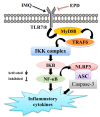Datura Metel L. Ameliorates Imiquimod-Induced Psoriasis-Like Dermatitis and Inhibits Inflammatory Cytokines Production through TLR7/8-MyD88-NF-κB-NLRP3 Inflammasome Pathway
- PMID: 31181689
- PMCID: PMC6600670
- DOI: 10.3390/molecules24112157
Datura Metel L. Ameliorates Imiquimod-Induced Psoriasis-Like Dermatitis and Inhibits Inflammatory Cytokines Production through TLR7/8-MyD88-NF-κB-NLRP3 Inflammasome Pathway
Abstract
Background: Psoriasis is a chronic, immune-mediated inflammatory skin disease, and the inflammatory response plays an important role in its development and progression. Datura metel L. is a traditional Chinese medicine that exhibited a significant therapeutic effect on psoriasis in our previous study due to its remarkable anti-inflammatory effect. Meanwhile, the mechanism underlying its effects on psoriasis is still unclear.
Methods: An imiquimod-induced psoriasis-like dermatitis mouse model was constructed to evaluate the protective effect of the effective part of Datura metel L. (EPD), which was verified by evaluations of the Psoriasis Area and Severity Index (PASI) score. Hematoxylin and eosin (H&E) staining, immunohistochemical examination, enzyme-linked immunosorbent assay (ELISA), and Western blot were used to measure the inflammatory cytokines and the protein expression associated with the Toll-like receptor 7- myeloid differentiation primary response gene 88-nuclear Factor-κB-nucleotide-binding oligomerization domain (Nod)-like receptor family pyrin domain-containing 3 (TLR7/8-MyD88-NF-κB-NLRP3) inflammasome pathway.
Results: EPD significantly decreased the PASI, reduced epidermal thickness, and decreased the proliferation and differentiation of epidermal cells in psoriasis-like dermatitis C57BL/6 mice induced by imiquimod (IMQ). Furthermore, EPD reduced the infiltration of CD3+ cells to psoriatic lesions, as well as ameliorated the elevations of intercellular adhesion molecule 1 (ICAM-1) and inhibited the production of imiquimod-induced inflammatory cytokines, including IL-1β, IL-2, IL-6, IL-10, IL-12, IL-17, IL-22, IL-23, tumor necrosis factor-α (TNF-α), monocyte chemotactic protein 1 (MCP-1), and interferon-γ (IFN-γ). Besides, EPD decreased the imiquimod-induced expression levels of TLR7, TLR8, TRAF6, MyD88, p-IKKα, p-IKBα, p-NF-κB, NLRP3, apoptosis-associated speck-like protein contained a caspase recruitment domain (ASC), cysteinyl aspartate specific proteinase 1 (caspase-1), and IL-1β.
Conclusion: This study demonstrated that EPD exhibited a protective effect on an imiquimod-induced psoriasis mice model by inhibiting the inflammatory response, which might be ascribed to the inhibition of the TLR7/8-MyD88-NF-κb-NLRP3 inflammasome pathway.
Keywords: Datura metel L.; imiquimod; inflammatory cytokines; psoriasis; toll-like receptor 7/8.
Conflict of interest statement
The authors declare that there are no conflicts of interest.
Figures








Similar articles
-
Chlorquinaldol inhibits the activation of nucleotide-binding oligomerization domain-like receptor family pyrin domain-containing protein 3 inflammasome and ameliorates imiquimod-induced psoriasis-like dermatitis in mice.Chem Biol Interact. 2022 Sep 25;365:110122. doi: 10.1016/j.cbi.2022.110122. Epub 2022 Aug 21. Chem Biol Interact. 2022. PMID: 36002070
-
Rutaecarpine inhibited imiquimod-induced psoriasis-like dermatitis via inhibiting the NF-κB and TLR7 pathways in mice.Biomed Pharmacother. 2019 Jan;109:1876-1883. doi: 10.1016/j.biopha.2018.10.062. Epub 2018 Nov 26. Biomed Pharmacother. 2019. PMID: 30551443
-
Hydrogen-Rich Saline Attenuated Subarachnoid Hemorrhage-Induced Early Brain Injury in Rats by Suppressing Inflammatory Response: Possible Involvement of NF-κB Pathway and NLRP3 Inflammasome.Mol Neurobiol. 2016 Jul;53(5):3462-3476. doi: 10.1007/s12035-015-9242-y. Epub 2015 Jun 20. Mol Neurobiol. 2016. PMID: 26091790
-
Cyclin-Dependent kinase 9 (CDK9) inhibitor Atuveciclib ameliorates Imiquimod-Induced Psoriasis-Like dermatitis in mice by inhibiting various inflammation factors via STAT3 signaling pathway.Int Immunopharmacol. 2024 Mar 10;129:111652. doi: 10.1016/j.intimp.2024.111652. Epub 2024 Feb 8. Int Immunopharmacol. 2024. PMID: 38335657 Review.
-
Targeting the NLRP3 inflammasome in psoriasis.Int J Dermatol. 2024 Jul;63(7):844-851. doi: 10.1111/ijd.17073. Epub 2024 Feb 12. Int J Dermatol. 2024. PMID: 38345734 Review.
Cited by
-
The Efficacy of Lactocare® Synbiotic on the Clinical Symptoms in Patients with Psoriasis: A Randomized, Double-Blind, Placebo-Controlled Clinical Trial.Dermatol Res Pract. 2022 Oct 7;2022:4549134. doi: 10.1155/2022/4549134. eCollection 2022. Dermatol Res Pract. 2022. PMID: 36249714 Free PMC article.
-
Comparative Study on Different Skin Pruritus Mouse Models.Front Med (Lausanne). 2021 Feb 23;8:630237. doi: 10.3389/fmed.2021.630237. eCollection 2021. Front Med (Lausanne). 2021. PMID: 33708782 Free PMC article.
-
Network analysis of potential risk genes for psoriasis.Hereditas. 2021 Jun 16;158(1):21. doi: 10.1186/s41065-021-00186-w. Hereditas. 2021. PMID: 34134787 Free PMC article.
-
Dendritic Cells and CCR7 Expression: An Important Factor for Autoimmune Diseases, Chronic Inflammation, and Cancer.Int J Mol Sci. 2021 Aug 3;22(15):8340. doi: 10.3390/ijms22158340. Int J Mol Sci. 2021. PMID: 34361107 Free PMC article. Review.
-
Quantitative Proteomic Analysis Indicates That Pggt1b Deficiency Promotes Cytokine Secretion in Resiquimod-Stimulated Bone Marrow-Derived Macrophages via the NF-κB Pathway.Immun Inflamm Dis. 2025 Apr;13(4):e70185. doi: 10.1002/iid3.70185. Immun Inflamm Dis. 2025. PMID: 40192076 Free PMC article.
References
-
- Terhorst D., Chelbi R., Wohn C., Malosse C., Tamoutounour S., Jorquera A., Bajenoff M., Dalod M., Malissen B., Henri S. Dynamics and Transcriptomics of Skin Dendritic Cells and Macrophages in an Imiquimod-Induced, Biphasic Mouse Model of Psoriasis. J. Immunol. 2015;195:4953–4961. doi: 10.4049/jimmunol.1500551. - DOI - PubMed
-
- Meng Y., Wang M., Xie X., Di T., Zhao J., Lin Y., Xu X., Li N., Zhai Y., Wang Y., et al. Paeonol ameliorates imiquimod-induced psoriasis-like skin lesions in BALB/c mice by inhibiting the maturation and activation of dendritic cells. Int. J. Mol. Med. 2017;39:1101–1110. doi: 10.3892/ijmm.2017.2930. - DOI - PMC - PubMed
-
- Chularojanamontri L., Wongpraparut C., Silpa-Archa N., Chaweekulrat P. Metabolic syndrome and psoriasis severity in South-East Asian patients: An investigation of potential association using current and chronological assessments. J. Dermatol. 2016;43:1424–1428. doi: 10.1111/1346-8138.13540. - DOI - PubMed
MeSH terms
Substances
Grants and funding
LinkOut - more resources
Full Text Sources
Medical
Research Materials
Miscellaneous

